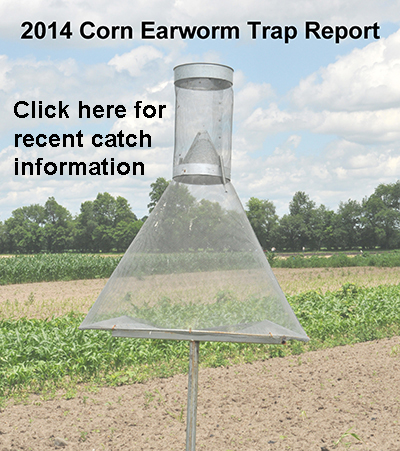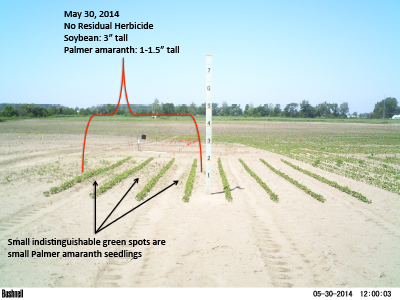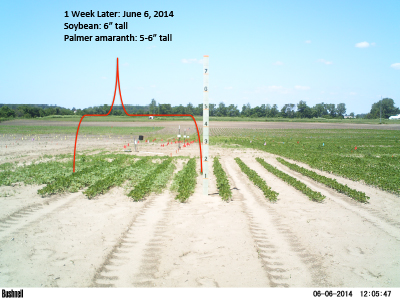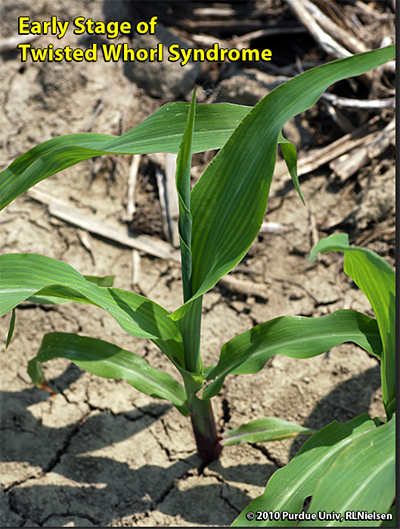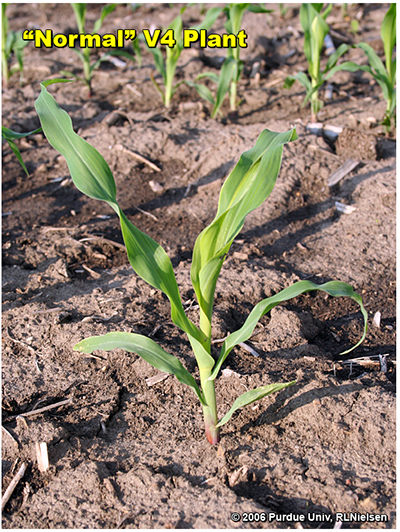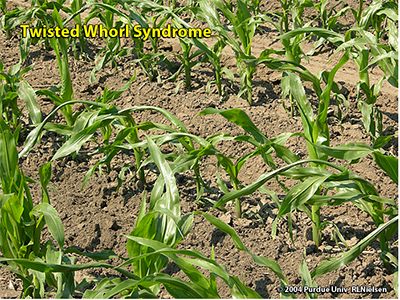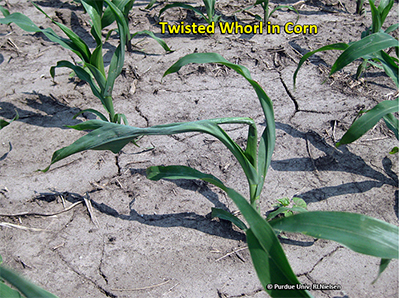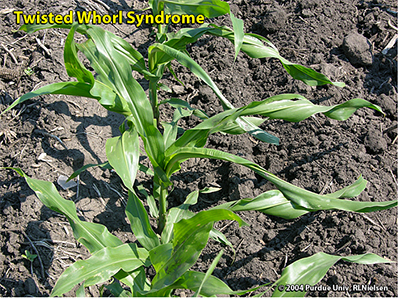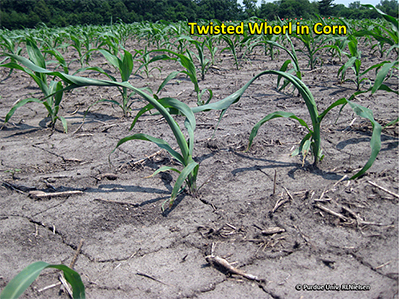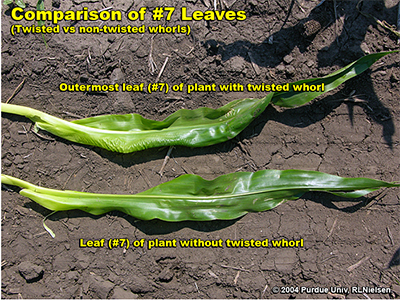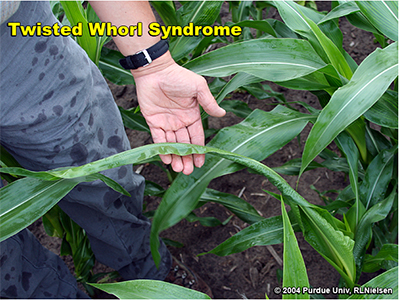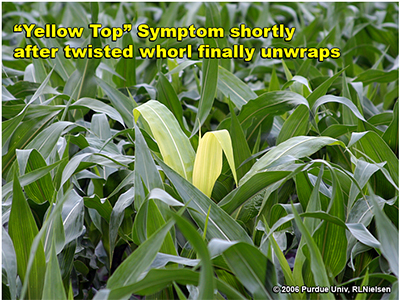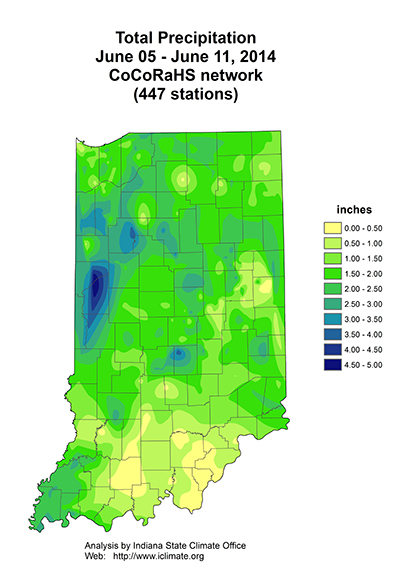USDA-NIFA Extension IPM Grant
Pest & Crop Newsletter, Entomology Extension, Purdue University
- Corn Earworm
- 2014 Corn Earworm Trap Report
- Armyworm Pheromone Trap Report
- Have You Scouted Your Palmer Amaranth In The Last 7 Days?
- Purdue Weed Science Field Days
- Wrapped and Twisted Whorls in Corn
- VIDEO: Early Soybean Stand Assessment: 30-inch Rows
- VIDEO: Early Soybean Stand Assessment: 15-inch Rows
- VIDEO: Early Soybean Stand Assessment: Drilled Rows
Corn Earworm – (Rick Foster) – We have been catching relatively low numbers of corn earworms in our pheromone traps for several weeks now. Growers with sweet corn at or approaching silking should have their earworm traps in place or be monitoring reported catches at the Purdue Ag Center nearest them at <http://extension.entm.purdue.edu/cornearworm/index.php>. Remember that we are now recommending treatment of sweet corn that silks prior to the silking of the neighboring field corn when any moths are being caught in your local trap and fresh green silks are present on your sweet corn. With the relatively low moth catches we are seeing, I recommend treating with an insecticide every 4 to 5 days from when about 50-70% of your plants are silking until the majority of silks have turned brown. See the Midwest Vegetable Production Guide (ID56) for insecticide choices. When neighboring field corn begins to silk, the threshold should increase to 10 moths per night in the pheromone trap.
2014 Corn Earworm Trap Report
![]()
Click here to see the Armyworm Pheromone Trap Report
![]()
Have You Scouted Your Palmer Amaranth In The Last 7 Days? – (Travis Legleiter and Bill Johnson) -
This year we decided to get serious about keeping an eye on our Palmer amaranth and placed a trail camera at our Cass county site to take pictures of the weeds every five minutes. The camera has been positioned to take pictures of two plots, one with a residual herbicide application and one without, from planting until Mid July.
The first couple of weeks did not provide many great pictures as the Palmer amaranth slowly emerged, in the unseasonably cold and rainy weather of Mid May. The week of May 30-June 6th however provided warm temperatures and timely rain events that promoted rapid growth of Palmer amaranth from small seedlings to 4-6” plants. In a weeks time the Palmer has gone from a very manageable weed to a weed that may only be marginally controlled with our available postemergence herbicides. Given another week or rather a few days the Palmer will likely be at an unmanageable growth stage.
These pictures will eventually be formatted in a time-lapse video to show the advantages of using a pre emergence herbicide as well the growth rate of Palmer. The impressiveness of this past week of photos has prompted us to give you a sneak peak with two photos one week apart when the Palmer went from 1-1.5” in height to 5-6” in height in the plot that did not receive a preemerge herbicide. Also note that the plot on the right that did receive a preemergence herbicide is still clean and free of Palmer amaranth pressure.
No residual herbicide May 30, 2014.
1 week later June 6, 2014.
![]()
Purdue Weed Science Field Days – (Bill Johnson and Travis Legleiter) -
The Purdue Weed Science program will be hosting Weed Science field days at 3 sites in 2014.
Our first field day will be held on Friday, June 27th, at our Palmer Amaranth research site near Twelve Mile, IN (intersection on 900 E and 800 N, Twelve Mile, IN 46988; GPS: 40.87745, -86.20647). Registration will begin at 8:00 EDT. The tours will start at 8:30 and conclude at noon. Enrollment is limited to 60 people for this field day. If you are interested in attending the field day at this site, please preregister at the Purdue DTC website: <https://ag.purdue.edu/agry/dtc/Pages/palmer.aspx>. We have applied for CCA and CCH credit for this site.
The second field day, Purdue Weed Day, is scheduled for Tuesday, July 1 at the Throckmorton Purdue Agricultural Center, 8343 US 231 South, Lafayette, IN 47909-9049. Registration will begin at 8:00 AM EDT, and the program will begin at 8:30. We will view the plots on the west side of highway 231 in the morning, and a waterhemp site about 1 mile east of the farm in the afternoon. The farm is located approximately 5 miles south of Lafayette on the corner of county road 800 South and U.S. 231 South. Come a little early and have coffee and a doughnut with us. Water and soft drinks will be available during the tour.
Our third field day will be held at another Palmer Amaranth research site near Evansville, IN on July 29th. We are hosting this field day in conjunction with Bayer Crop Science’s Respect the Rotation educational event. More details will be posted on the Purdue Weed Science Facebook site as they become available.
An attendance form is located on the Purdue Weed Science Website at <http://www.btny.purdue.edu/weedscience/temp/WeedDay2013.html>. You may also call Lisa Gross at 765-494-9871. Please register if you plan to attend. This will allow us to maintain a mailing list and to estimate coffee, doughnut and soft drink needs for our Weed Science field days.
![]()
Wrapped and Twisted Whorls in Corn – (Bob Nielsen)
The curious phenomenon often referred to as the “twisted whorl syndrome” is beginning to show up in some fields in recent days. This “problem” often occurs when young corn shifts quickly from weeks of slow development (cool, cloudy weather) to rapid development (warm, sunny weather). Earlier planted corn has certainly experienced such a change in weather conditions in recent weeks. The occurrence of the twisted whorl syndrome is not uncommon, but rarely affects a large number of fields in any given year or a large percentage of plants within a field.
The typical growth stage when growers notice the twisted whorls is late V5 to early V6 (five to six visible leaf collars, approximately knee-high). The lowermost leaves are typically normal in appearance, although some may exhibit some crinkled (accordion-like) tissue near the base of the leaf blade. Beginning with the sixth or seventh leaf, the whorl is tightly wrapped and often bent over at right angles to the ground.
Early stage of twisted whorl syndrome.
Normal V4 Plant
Sometimes you can spot the early onset of this phenomenon one or two leaf stages prior to the dramatic appearance of the phenomenon. The early stages of twisted whorl are not dramatic to the casual observer, but will catch the eye of the seasoned crop scout.
I will freely admit that we do not fully understand why this symptom develops. For some reason, the leaves of the whorl of affected plants do not unfurl properly, as if the rolled leaf tissue has lost its elasticity or has become “sticky”. Younger leaves developing deeper in the whorl are unable to emerge through the tightly wrapped upper leaves. The subsequently tightly twisted whorl then bends and kinks from the pressure exerted from the younger leaves’ continued growth.
A natural instinct is to blame the twisted growth on herbicide injury. Indeed, where cell growth inhibitor or growth regulator herbicides are applied pre-plant or pre-emergence, shoot uptake of the herbicide by the emerging seedlings can indeed cause twisted growth of the young plants. Late application of growth regulators can also cause twisted whorls in older plants when leaves and whorl intercept a substantial amount of the herbicide. Widespread occurrence of the twisted whorl syndrome is not, however, always accompanied by the common thread of any particular herbicide application.
Some have questioned whether wind damage can give rise to this phenomenon by somehow damaging the young inner whorl leaves. I have not often tracked the occurrence of strong winds with the development of the twisted whorl symptom, but it’s no secret that there were a number of strong storm and wind events throughout the state over the past couple of weeks. In the past few days, strong winds have been accompanied by unusually warm temperatures.
Twisted Whorl Syndrome
Twisted Whorl Syndrome
Twisted Whorl Syndrome
In other situations over the years, this phenomenon has often been associated with a sharp transition from periods of slow corn development (typically, cool cloudy weather) to periods of rapid corn development (typically, warm sunny weather plus ample moisture). Some have argued that it is the reverse, transitioning from rapid periods of development to slow. Or…….maybe it is a transition from rapid development to slow and back to rapid that triggers the symptoms.
Whatever the cause, the appearance of the twisted whorl plants is indeed unsettling and one could easily imagine that the twisted whorls might never unfurl properly. Given another week, though, twisted whorls of most of the plants will unfurl and affected plants subsequently develop normally. It is not uncommon to see hybrids vary in the frequency of twisted whorls.
Twisted Whorl Syndrome
If you didn’t notice the twisted whorls to begin with, you may notice the appearance of “yellow tops” across the field after the whorls unfurl. The younger leaves that had been trapped inside the twisted upper leaves emerge fairly yellow due to the fact that they had been shaded for quite some time. In addition to being fairly yellow, the leaves will exhibit a crinkly surface caused by their restricted expansion inside the twisted whorl. Another day or two will green these up and the problem will no longer be visible.
The Good News: Yield effects from periods of twisted growth caused by weather-related causes are minimal, if any. By the time the affected plants reach waist to chest-high, the only evidence that remains of the previous twisted whorls is the crinkled appearance of the most-affected leaves.
Twisted Whorl Syndrome
Comparison of #7 Leaves
Twisted Whorl Syndrome
Yellow Top symptom shortly after twisted whorl finally unwraps
VIDEOS: Early Soybean Stand Assessment - (Shaun Casteel and John Obermeyer)
This year, there certainly have been challenges in achieving satisfactory soybean plant populations. Time is of the essence to assess emerging soybean fields to determine the need for interplanting to strengthen stands or replanting weak (e.g., ponded) areas. The following videos demonstrate how to take proper soybean plant stands in drilled, 15-inch, and 30-inch rows. The hula hoop method is preferred for narrow rows, as linear measure is best in wide rows. All are based on 1/10,000th of an acre measurement. Multiple counts throughout the field provides a better assessment in replanting decisions. We hope these videos are of help:
![]()

